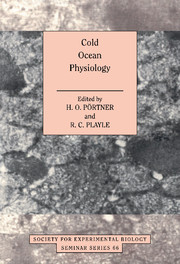Book contents
- Frontmatter
- Contents
- List of contributors
- Preface
- PART I General concepts
- PART II Compensatory adaptations in cold ocean environments
- PART III Exploitative adaptations
- New insights into fish antifreeze proteins: physiological significance and molecular regulation
- Antifreeze glycopeptides and peptides in the freezing avoidance of Weddell Sea fishes: its relation to mode of life, depth distribution and evolution
- PART IV Integrative approaches
- PART V Applied approaches
- Index
Antifreeze glycopeptides and peptides in the freezing avoidance of Weddell Sea fishes: its relation to mode of life, depth distribution and evolution
Published online by Cambridge University Press: 13 March 2010
- Frontmatter
- Contents
- List of contributors
- Preface
- PART I General concepts
- PART II Compensatory adaptations in cold ocean environments
- PART III Exploitative adaptations
- New insights into fish antifreeze proteins: physiological significance and molecular regulation
- Antifreeze glycopeptides and peptides in the freezing avoidance of Weddell Sea fishes: its relation to mode of life, depth distribution and evolution
- PART IV Integrative approaches
- PART V Applied approaches
- Index
Summary
Low temperatures have pervaded the Southern Ocean for some 40 million years (Kennett, 1977). Recent data suggest relatively constant low temperatures (+3°C to −2°C, Hellmer & Bersch, 1985) for the last 13 million years (Eastman & Grande, 1989). This phenomenon may have led to the high degree of stenothermy and endemism of the fish fauna (DeVries & Eastman, 1981). The temperature of large portions of Southern Ocean is less than 0°C with only small differences between water temperatures in winter and summer. South of 60° S there is usually less than 2° C difference in the mean surface water temperature between the warmest and coldest months (Deacon, 1984), and the water masses throughout most of the Southern Ocean, from the surface to great depths, differ by only 4–5°C (Knox, 1970). Close to the continental shelf waters are always at or below the freezing point of seawater (−1.86°C) and are thermally stable throughout the year.
A variety of physical characteristics of cold sea-water has certainly influenced the evolutionary adaptation of the fish fauna in the Southern Ocean. However, it must be considered that over 90% of the global seawater is below 5° C. Therefore, for marine organisms, cold water is not an unusual environment and low temperature as such is unlikely to be a limiting factor for biosynthetic processes (for review, see Clarke, 1983, 1987). In addition to low temperature, the continual presence of ice in subzero water presents fishes with another physiological challenge.
- Type
- Chapter
- Information
- Cold Ocean Physiology , pp. 266 - 296Publisher: Cambridge University PressPrint publication year: 1998

